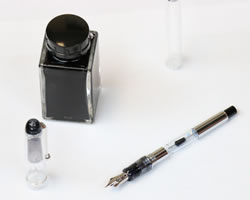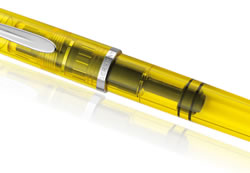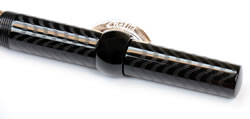Best Fountain Pen Fill Mechanisms - Converter, Piston
Q:
What are the different type of fill systems for fountain pens? Which is the best and why?A:
There are many different types fill mechanisms for fountain pens. Since there are so many we will only discuss some of the most common and the advantages and disadvantages of each.Cartridge Fountain Pens
 Most modern fountain pens are of this style. These fountain pens accept ink cartridges. Some will also use an ink converter as well.
Most modern fountain pens are of this style. These fountain pens accept ink cartridges. Some will also use an ink converter as well. Ink cartridges are small disposable tubes filled with fountain pen ink. They are inserted into the pen and when the ink runs out you simply replace it with a new one. These ink cartridges are great for travel or mobility but limit the amount of ink as well as the ink selection. A lot of brands use a standard international ink cartridge size so you can use other brands. Many however, are proprietary and will only accept their own brand limiting you to their ink selection.
Pros
Easy to transport and carry ink.
Easy and clean ink replacement.
Cons
Limit to the color and selection of fountain pen inks.
Converter Fountain Pens
 An ink converter "converts" the cartridge style pen so that it can use bottled fountain pen inks as well. Rather than an ink cartridge you insert the converter onto the pen. You can then draw ink through the nib and feed from an ink bottle. This allows you to use limitless brands and colors of inks.
An ink converter "converts" the cartridge style pen so that it can use bottled fountain pen inks as well. Rather than an ink cartridge you insert the converter onto the pen. You can then draw ink through the nib and feed from an ink bottle. This allows you to use limitless brands and colors of inks.Pros
Larger ink selection than simply cartridges.
Cons
Lower ink capacity within the pen.
Piston Fountain Pens
 Another popular fill system for fountain pens is the piston mechanism. The piston is similar in the way it works as the converter but instead of being removable the piston is permanent. This means the pen uses bottled inks but cannot also use a cartridge. The main advantage over the cartridge/converter style is the piston fountain pens will hold more ink.
Another popular fill system for fountain pens is the piston mechanism. The piston is similar in the way it works as the converter but instead of being removable the piston is permanent. This means the pen uses bottled inks but cannot also use a cartridge. The main advantage over the cartridge/converter style is the piston fountain pens will hold more ink.Piston mechanisms have different ways they operate. Most use a twist knob that actuates a piston. Others slide as the knob is pulled or pushed. Regardless, as the piston is drawn towards the back of the pen with the nib in the ink bottle a vacuum is created and ink is pulled inside the pen.
Pros
Larger ink selection.
Larger ink capacity within the pen.
Cons
More difficult to travel since you would have to take a bottle of ink for refills.
Eyedropper Fountain Pens
Eyedropper fountain pens are filled using an eyedropper or syringe to transfer ink from the ink bottle inside the barrel of the pen.Pros
Able to fill pen to full capacity.
Easy to view ink level with demonstrator fountain pens.
Cons
More difficult to fill the fountain pen without spilling ink.
Bladder/Vacuum Sac Fountain Pens
 There are several different types of fountain pens that use a rubber ink sac within the pen. Each type just uses a different way to compress the internal ink sac in order to fill the pen. These include the button filler, crescent filler, or lever filler.
There are several different types of fountain pens that use a rubber ink sac within the pen. Each type just uses a different way to compress the internal ink sac in order to fill the pen. These include the button filler, crescent filler, or lever filler. Cons
The ink sac doesn't last forever and may need to be replaced.
Harder to completely fill the ink sac.
When choosing the right fountain pen consider these different filling systems and how you plan on using the pen. Each filling mechanism has it's own advantages and disadvantages. Weigh each of these and you will pick the fountain pen that best suits your needs.



